Managerial Skills: Communication, Culture and Career Growth
VerifiedAdded on 2024/06/12
|23
|5578
|256
Report
AI Summary
This report provides a comprehensive analysis of management styles, leadership characteristics, communication processes, and organizational culture within the context of the UK travel and tourism industry, specifically focusing on White Chapel Tourism Development Company and Hilton Group of Hotels. It includes a self-assessment of the author's management skills, highlighting strengths, weaknesses, opportunities, and threats, leading to the development of personal objectives and targets. Furthermore, the report addresses team leadership and motivation strategies, justifying managerial decisions and proposing improvements. Finally, it outlines how the author's managerial and personal skills will support career development, culminating in a detailed career and personal development plan.
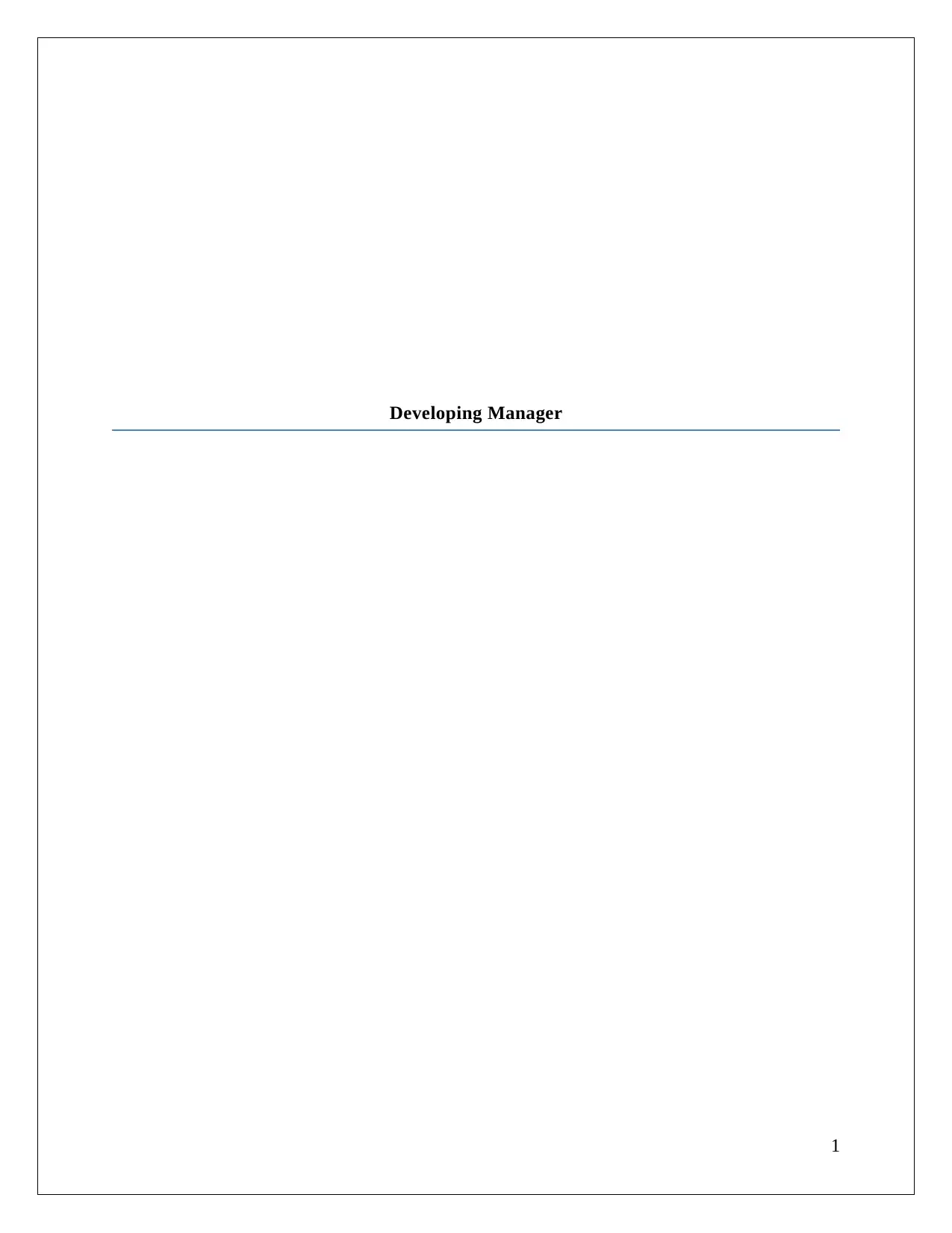
Developing Manager
1
1
Paraphrase This Document
Need a fresh take? Get an instant paraphrase of this document with our AI Paraphraser
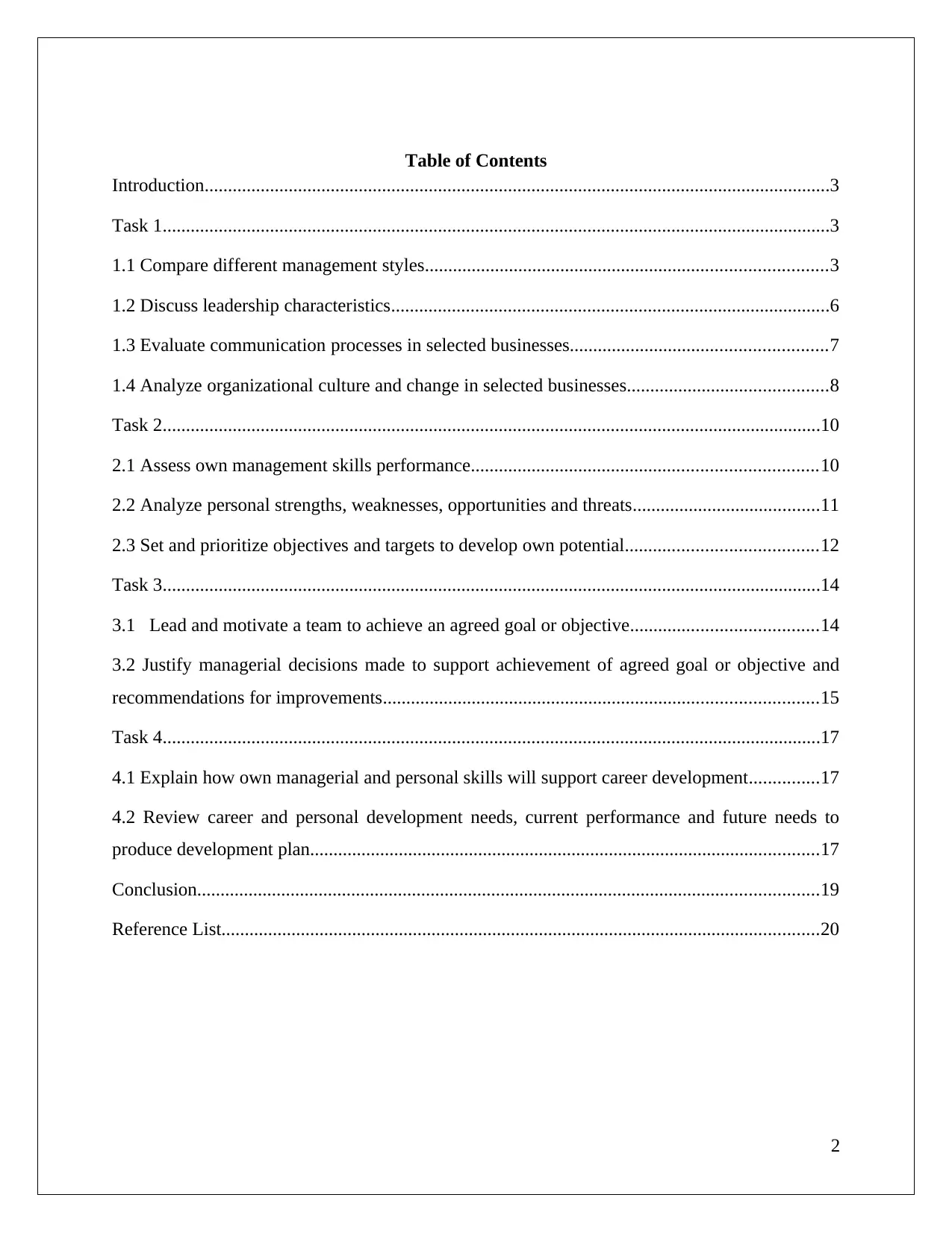
Table of Contents
Introduction......................................................................................................................................3
Task 1...............................................................................................................................................3
1.1 Compare different management styles......................................................................................3
1.2 Discuss leadership characteristics..............................................................................................6
1.3 Evaluate communication processes in selected businesses.......................................................7
1.4 Analyze organizational culture and change in selected businesses...........................................8
Task 2.............................................................................................................................................10
2.1 Assess own management skills performance..........................................................................10
2.2 Analyze personal strengths, weaknesses, opportunities and threats........................................11
2.3 Set and prioritize objectives and targets to develop own potential.........................................12
Task 3.............................................................................................................................................14
3.1 Lead and motivate a team to achieve an agreed goal or objective........................................14
3.2 Justify managerial decisions made to support achievement of agreed goal or objective and
recommendations for improvements.............................................................................................15
Task 4.............................................................................................................................................17
4.1 Explain how own managerial and personal skills will support career development...............17
4.2 Review career and personal development needs, current performance and future needs to
produce development plan.............................................................................................................17
Conclusion.....................................................................................................................................19
Reference List................................................................................................................................20
2
Introduction......................................................................................................................................3
Task 1...............................................................................................................................................3
1.1 Compare different management styles......................................................................................3
1.2 Discuss leadership characteristics..............................................................................................6
1.3 Evaluate communication processes in selected businesses.......................................................7
1.4 Analyze organizational culture and change in selected businesses...........................................8
Task 2.............................................................................................................................................10
2.1 Assess own management skills performance..........................................................................10
2.2 Analyze personal strengths, weaknesses, opportunities and threats........................................11
2.3 Set and prioritize objectives and targets to develop own potential.........................................12
Task 3.............................................................................................................................................14
3.1 Lead and motivate a team to achieve an agreed goal or objective........................................14
3.2 Justify managerial decisions made to support achievement of agreed goal or objective and
recommendations for improvements.............................................................................................15
Task 4.............................................................................................................................................17
4.1 Explain how own managerial and personal skills will support career development...............17
4.2 Review career and personal development needs, current performance and future needs to
produce development plan.............................................................................................................17
Conclusion.....................................................................................................................................19
Reference List................................................................................................................................20
2
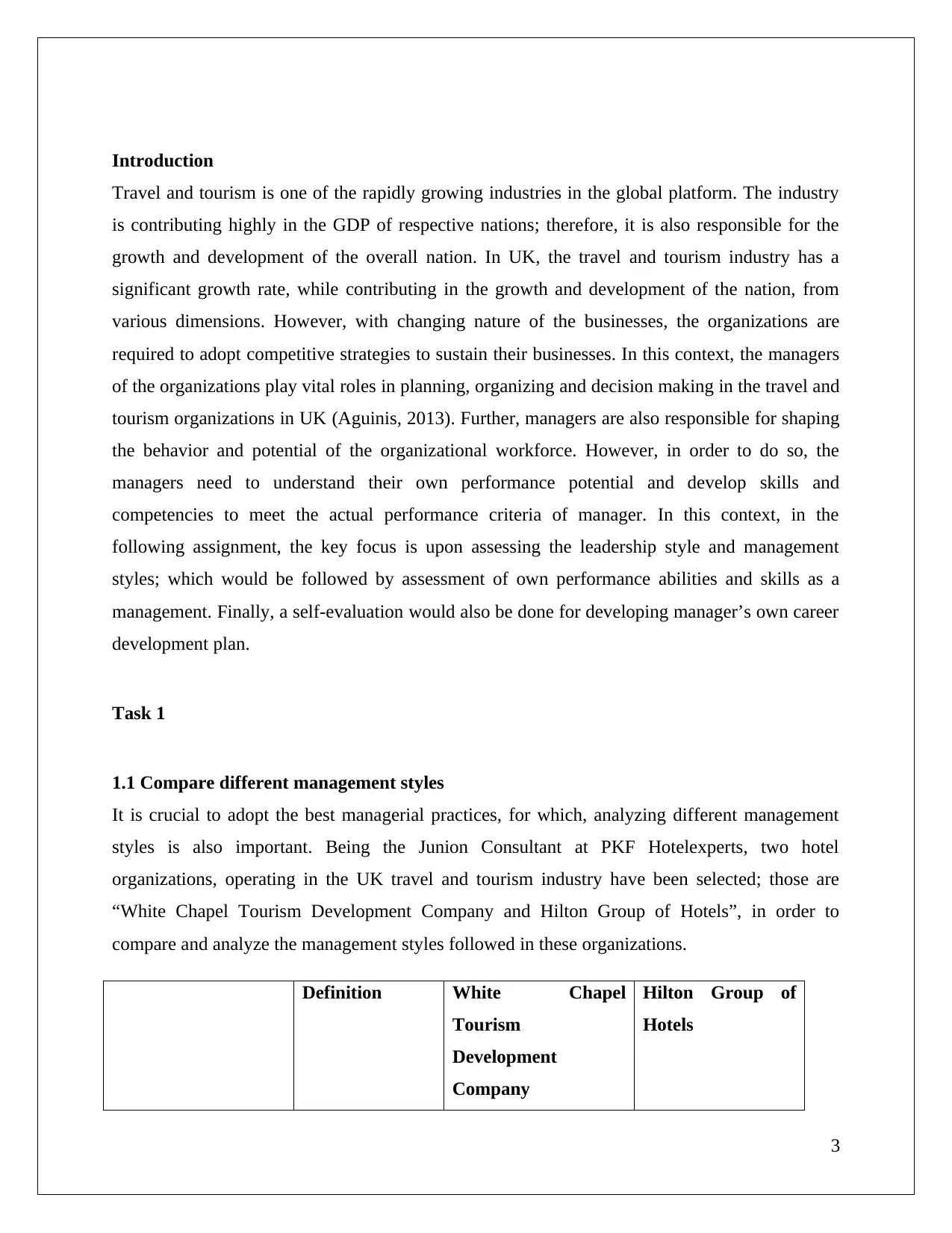
Introduction
Travel and tourism is one of the rapidly growing industries in the global platform. The industry
is contributing highly in the GDP of respective nations; therefore, it is also responsible for the
growth and development of the overall nation. In UK, the travel and tourism industry has a
significant growth rate, while contributing in the growth and development of the nation, from
various dimensions. However, with changing nature of the businesses, the organizations are
required to adopt competitive strategies to sustain their businesses. In this context, the managers
of the organizations play vital roles in planning, organizing and decision making in the travel and
tourism organizations in UK (Aguinis, 2013). Further, managers are also responsible for shaping
the behavior and potential of the organizational workforce. However, in order to do so, the
managers need to understand their own performance potential and develop skills and
competencies to meet the actual performance criteria of manager. In this context, in the
following assignment, the key focus is upon assessing the leadership style and management
styles; which would be followed by assessment of own performance abilities and skills as a
management. Finally, a self-evaluation would also be done for developing manager’s own career
development plan.
Task 1
1.1 Compare different management styles
It is crucial to adopt the best managerial practices, for which, analyzing different management
styles is also important. Being the Junion Consultant at PKF Hotelexperts, two hotel
organizations, operating in the UK travel and tourism industry have been selected; those are
“White Chapel Tourism Development Company and Hilton Group of Hotels”, in order to
compare and analyze the management styles followed in these organizations.
Definition White Chapel
Tourism
Development
Company
Hilton Group of
Hotels
3
Travel and tourism is one of the rapidly growing industries in the global platform. The industry
is contributing highly in the GDP of respective nations; therefore, it is also responsible for the
growth and development of the overall nation. In UK, the travel and tourism industry has a
significant growth rate, while contributing in the growth and development of the nation, from
various dimensions. However, with changing nature of the businesses, the organizations are
required to adopt competitive strategies to sustain their businesses. In this context, the managers
of the organizations play vital roles in planning, organizing and decision making in the travel and
tourism organizations in UK (Aguinis, 2013). Further, managers are also responsible for shaping
the behavior and potential of the organizational workforce. However, in order to do so, the
managers need to understand their own performance potential and develop skills and
competencies to meet the actual performance criteria of manager. In this context, in the
following assignment, the key focus is upon assessing the leadership style and management
styles; which would be followed by assessment of own performance abilities and skills as a
management. Finally, a self-evaluation would also be done for developing manager’s own career
development plan.
Task 1
1.1 Compare different management styles
It is crucial to adopt the best managerial practices, for which, analyzing different management
styles is also important. Being the Junion Consultant at PKF Hotelexperts, two hotel
organizations, operating in the UK travel and tourism industry have been selected; those are
“White Chapel Tourism Development Company and Hilton Group of Hotels”, in order to
compare and analyze the management styles followed in these organizations.
Definition White Chapel
Tourism
Development
Company
Hilton Group of
Hotels
3
⊘ This is a preview!⊘
Do you want full access?
Subscribe today to unlock all pages.

Trusted by 1+ million students worldwide
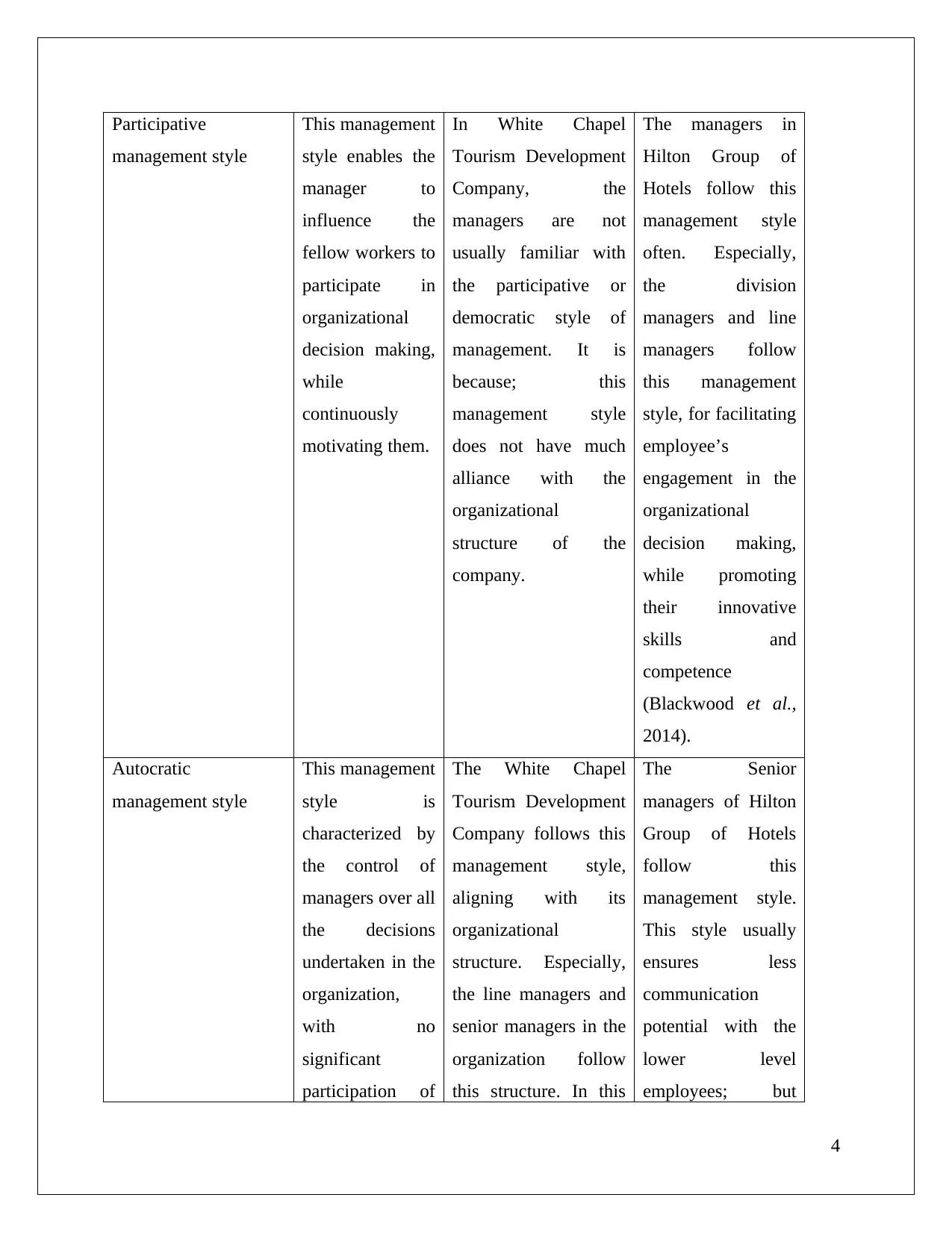
Participative
management style
This management
style enables the
manager to
influence the
fellow workers to
participate in
organizational
decision making,
while
continuously
motivating them.
In White Chapel
Tourism Development
Company, the
managers are not
usually familiar with
the participative or
democratic style of
management. It is
because; this
management style
does not have much
alliance with the
organizational
structure of the
company.
The managers in
Hilton Group of
Hotels follow this
management style
often. Especially,
the division
managers and line
managers follow
this management
style, for facilitating
employee’s
engagement in the
organizational
decision making,
while promoting
their innovative
skills and
competence
(Blackwood et al.,
2014).
Autocratic
management style
This management
style is
characterized by
the control of
managers over all
the decisions
undertaken in the
organization,
with no
significant
participation of
The White Chapel
Tourism Development
Company follows this
management style,
aligning with its
organizational
structure. Especially,
the line managers and
senior managers in the
organization follow
this structure. In this
The Senior
managers of Hilton
Group of Hotels
follow this
management style.
This style usually
ensures less
communication
potential with the
lower level
employees; but
4
management style
This management
style enables the
manager to
influence the
fellow workers to
participate in
organizational
decision making,
while
continuously
motivating them.
In White Chapel
Tourism Development
Company, the
managers are not
usually familiar with
the participative or
democratic style of
management. It is
because; this
management style
does not have much
alliance with the
organizational
structure of the
company.
The managers in
Hilton Group of
Hotels follow this
management style
often. Especially,
the division
managers and line
managers follow
this management
style, for facilitating
employee’s
engagement in the
organizational
decision making,
while promoting
their innovative
skills and
competence
(Blackwood et al.,
2014).
Autocratic
management style
This management
style is
characterized by
the control of
managers over all
the decisions
undertaken in the
organization,
with no
significant
participation of
The White Chapel
Tourism Development
Company follows this
management style,
aligning with its
organizational
structure. Especially,
the line managers and
senior managers in the
organization follow
this structure. In this
The Senior
managers of Hilton
Group of Hotels
follow this
management style.
This style usually
ensures less
communication
potential with the
lower level
employees; but
4
Paraphrase This Document
Need a fresh take? Get an instant paraphrase of this document with our AI Paraphraser
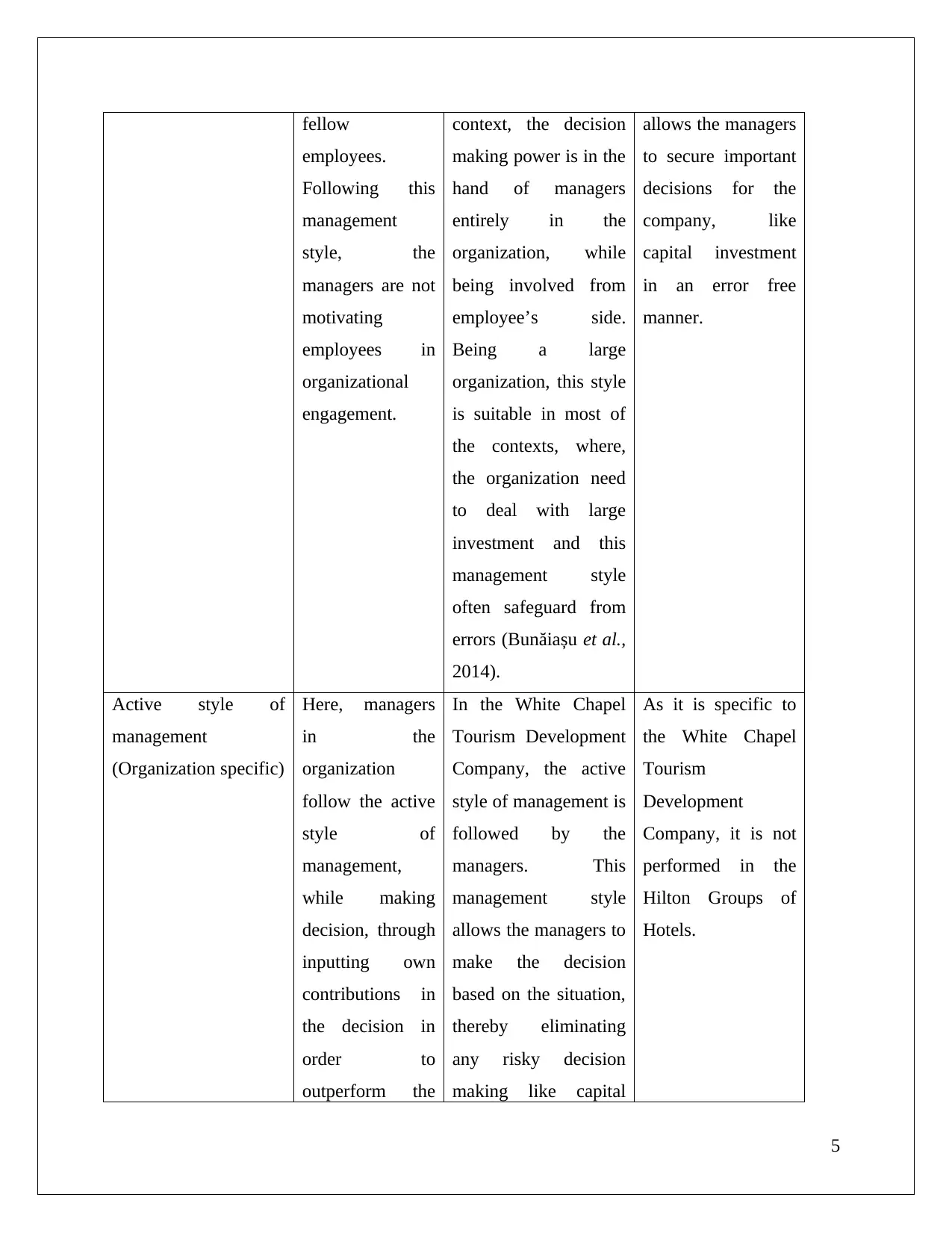
fellow
employees.
Following this
management
style, the
managers are not
motivating
employees in
organizational
engagement.
context, the decision
making power is in the
hand of managers
entirely in the
organization, while
being involved from
employee’s side.
Being a large
organization, this style
is suitable in most of
the contexts, where,
the organization need
to deal with large
investment and this
management style
often safeguard from
errors (Bunăiașu et al.,
2014).
allows the managers
to secure important
decisions for the
company, like
capital investment
in an error free
manner.
Active style of
management
(Organization specific)
Here, managers
in the
organization
follow the active
style of
management,
while making
decision, through
inputting own
contributions in
the decision in
order to
outperform the
In the White Chapel
Tourism Development
Company, the active
style of management is
followed by the
managers. This
management style
allows the managers to
make the decision
based on the situation,
thereby eliminating
any risky decision
making like capital
As it is specific to
the White Chapel
Tourism
Development
Company, it is not
performed in the
Hilton Groups of
Hotels.
5
employees.
Following this
management
style, the
managers are not
motivating
employees in
organizational
engagement.
context, the decision
making power is in the
hand of managers
entirely in the
organization, while
being involved from
employee’s side.
Being a large
organization, this style
is suitable in most of
the contexts, where,
the organization need
to deal with large
investment and this
management style
often safeguard from
errors (Bunăiașu et al.,
2014).
allows the managers
to secure important
decisions for the
company, like
capital investment
in an error free
manner.
Active style of
management
(Organization specific)
Here, managers
in the
organization
follow the active
style of
management,
while making
decision, through
inputting own
contributions in
the decision in
order to
outperform the
In the White Chapel
Tourism Development
Company, the active
style of management is
followed by the
managers. This
management style
allows the managers to
make the decision
based on the situation,
thereby eliminating
any risky decision
making like capital
As it is specific to
the White Chapel
Tourism
Development
Company, it is not
performed in the
Hilton Groups of
Hotels.
5
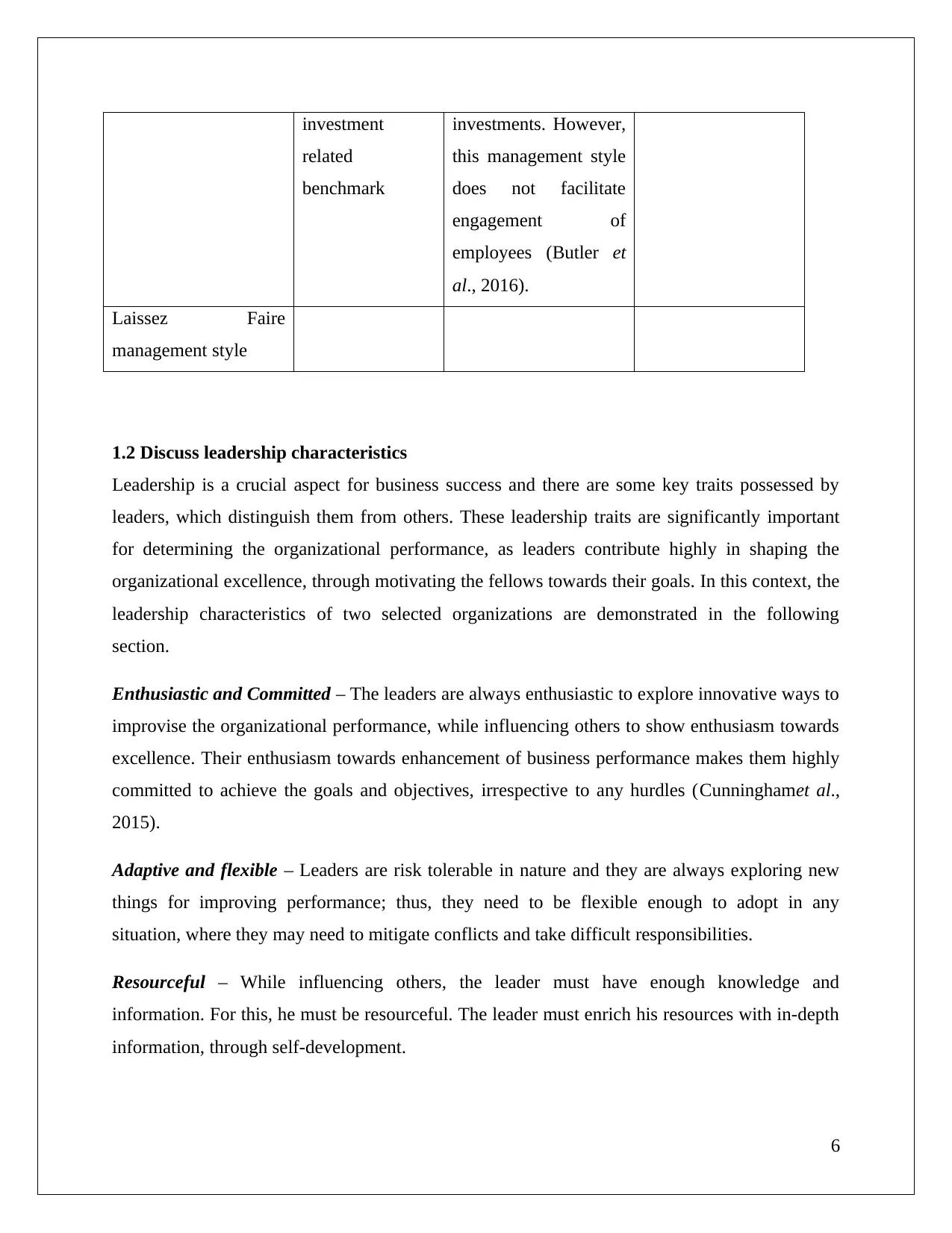
investment
related
benchmark
investments. However,
this management style
does not facilitate
engagement of
employees (Butler et
al., 2016).
Laissez Faire
management style
1.2 Discuss leadership characteristics
Leadership is a crucial aspect for business success and there are some key traits possessed by
leaders, which distinguish them from others. These leadership traits are significantly important
for determining the organizational performance, as leaders contribute highly in shaping the
organizational excellence, through motivating the fellows towards their goals. In this context, the
leadership characteristics of two selected organizations are demonstrated in the following
section.
Enthusiastic and Committed – The leaders are always enthusiastic to explore innovative ways to
improvise the organizational performance, while influencing others to show enthusiasm towards
excellence. Their enthusiasm towards enhancement of business performance makes them highly
committed to achieve the goals and objectives, irrespective to any hurdles (Cunninghamet al.,
2015).
Adaptive and flexible – Leaders are risk tolerable in nature and they are always exploring new
things for improving performance; thus, they need to be flexible enough to adopt in any
situation, where they may need to mitigate conflicts and take difficult responsibilities.
Resourceful – While influencing others, the leader must have enough knowledge and
information. For this, he must be resourceful. The leader must enrich his resources with in-depth
information, through self-development.
6
related
benchmark
investments. However,
this management style
does not facilitate
engagement of
employees (Butler et
al., 2016).
Laissez Faire
management style
1.2 Discuss leadership characteristics
Leadership is a crucial aspect for business success and there are some key traits possessed by
leaders, which distinguish them from others. These leadership traits are significantly important
for determining the organizational performance, as leaders contribute highly in shaping the
organizational excellence, through motivating the fellows towards their goals. In this context, the
leadership characteristics of two selected organizations are demonstrated in the following
section.
Enthusiastic and Committed – The leaders are always enthusiastic to explore innovative ways to
improvise the organizational performance, while influencing others to show enthusiasm towards
excellence. Their enthusiasm towards enhancement of business performance makes them highly
committed to achieve the goals and objectives, irrespective to any hurdles (Cunninghamet al.,
2015).
Adaptive and flexible – Leaders are risk tolerable in nature and they are always exploring new
things for improving performance; thus, they need to be flexible enough to adopt in any
situation, where they may need to mitigate conflicts and take difficult responsibilities.
Resourceful – While influencing others, the leader must have enough knowledge and
information. For this, he must be resourceful. The leader must enrich his resources with in-depth
information, through self-development.
6
⊘ This is a preview!⊘
Do you want full access?
Subscribe today to unlock all pages.

Trusted by 1+ million students worldwide
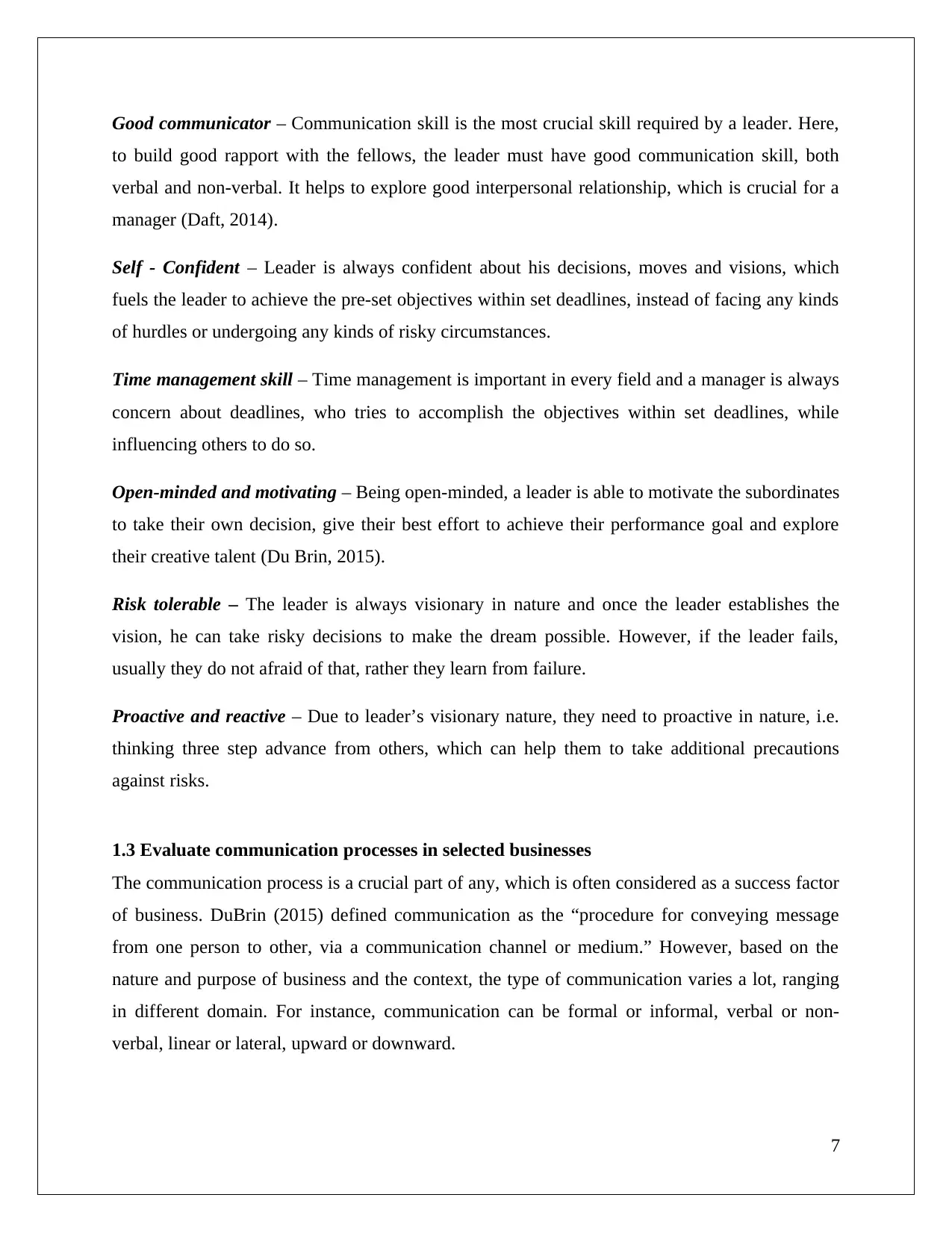
Good communicator – Communication skill is the most crucial skill required by a leader. Here,
to build good rapport with the fellows, the leader must have good communication skill, both
verbal and non-verbal. It helps to explore good interpersonal relationship, which is crucial for a
manager (Daft, 2014).
Self - Confident – Leader is always confident about his decisions, moves and visions, which
fuels the leader to achieve the pre-set objectives within set deadlines, instead of facing any kinds
of hurdles or undergoing any kinds of risky circumstances.
Time management skill – Time management is important in every field and a manager is always
concern about deadlines, who tries to accomplish the objectives within set deadlines, while
influencing others to do so.
Open-minded and motivating – Being open-minded, a leader is able to motivate the subordinates
to take their own decision, give their best effort to achieve their performance goal and explore
their creative talent (Du Brin, 2015).
Risk tolerable – The leader is always visionary in nature and once the leader establishes the
vision, he can take risky decisions to make the dream possible. However, if the leader fails,
usually they do not afraid of that, rather they learn from failure.
Proactive and reactive – Due to leader’s visionary nature, they need to proactive in nature, i.e.
thinking three step advance from others, which can help them to take additional precautions
against risks.
1.3 Evaluate communication processes in selected businesses
The communication process is a crucial part of any, which is often considered as a success factor
of business. DuBrin (2015) defined communication as the “procedure for conveying message
from one person to other, via a communication channel or medium.” However, based on the
nature and purpose of business and the context, the type of communication varies a lot, ranging
in different domain. For instance, communication can be formal or informal, verbal or non-
verbal, linear or lateral, upward or downward.
7
to build good rapport with the fellows, the leader must have good communication skill, both
verbal and non-verbal. It helps to explore good interpersonal relationship, which is crucial for a
manager (Daft, 2014).
Self - Confident – Leader is always confident about his decisions, moves and visions, which
fuels the leader to achieve the pre-set objectives within set deadlines, instead of facing any kinds
of hurdles or undergoing any kinds of risky circumstances.
Time management skill – Time management is important in every field and a manager is always
concern about deadlines, who tries to accomplish the objectives within set deadlines, while
influencing others to do so.
Open-minded and motivating – Being open-minded, a leader is able to motivate the subordinates
to take their own decision, give their best effort to achieve their performance goal and explore
their creative talent (Du Brin, 2015).
Risk tolerable – The leader is always visionary in nature and once the leader establishes the
vision, he can take risky decisions to make the dream possible. However, if the leader fails,
usually they do not afraid of that, rather they learn from failure.
Proactive and reactive – Due to leader’s visionary nature, they need to proactive in nature, i.e.
thinking three step advance from others, which can help them to take additional precautions
against risks.
1.3 Evaluate communication processes in selected businesses
The communication process is a crucial part of any, which is often considered as a success factor
of business. DuBrin (2015) defined communication as the “procedure for conveying message
from one person to other, via a communication channel or medium.” However, based on the
nature and purpose of business and the context, the type of communication varies a lot, ranging
in different domain. For instance, communication can be formal or informal, verbal or non-
verbal, linear or lateral, upward or downward.
7
Paraphrase This Document
Need a fresh take? Get an instant paraphrase of this document with our AI Paraphraser
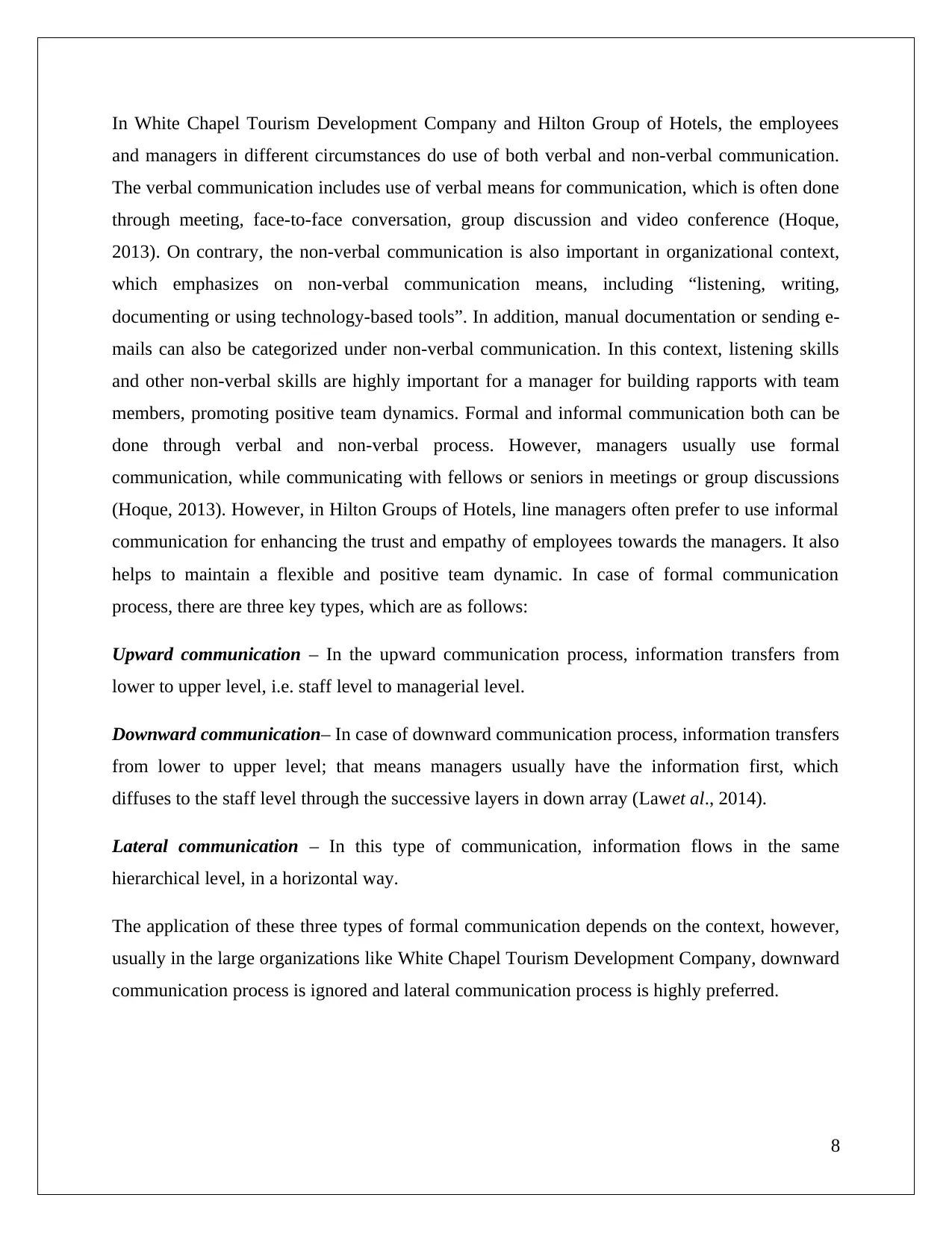
In White Chapel Tourism Development Company and Hilton Group of Hotels, the employees
and managers in different circumstances do use of both verbal and non-verbal communication.
The verbal communication includes use of verbal means for communication, which is often done
through meeting, face-to-face conversation, group discussion and video conference (Hoque,
2013). On contrary, the non-verbal communication is also important in organizational context,
which emphasizes on non-verbal communication means, including “listening, writing,
documenting or using technology-based tools”. In addition, manual documentation or sending e-
mails can also be categorized under non-verbal communication. In this context, listening skills
and other non-verbal skills are highly important for a manager for building rapports with team
members, promoting positive team dynamics. Formal and informal communication both can be
done through verbal and non-verbal process. However, managers usually use formal
communication, while communicating with fellows or seniors in meetings or group discussions
(Hoque, 2013). However, in Hilton Groups of Hotels, line managers often prefer to use informal
communication for enhancing the trust and empathy of employees towards the managers. It also
helps to maintain a flexible and positive team dynamic. In case of formal communication
process, there are three key types, which are as follows:
Upward communication – In the upward communication process, information transfers from
lower to upper level, i.e. staff level to managerial level.
Downward communication– In case of downward communication process, information transfers
from lower to upper level; that means managers usually have the information first, which
diffuses to the staff level through the successive layers in down array (Lawet al., 2014).
Lateral communication – In this type of communication, information flows in the same
hierarchical level, in a horizontal way.
The application of these three types of formal communication depends on the context, however,
usually in the large organizations like White Chapel Tourism Development Company, downward
communication process is ignored and lateral communication process is highly preferred.
8
and managers in different circumstances do use of both verbal and non-verbal communication.
The verbal communication includes use of verbal means for communication, which is often done
through meeting, face-to-face conversation, group discussion and video conference (Hoque,
2013). On contrary, the non-verbal communication is also important in organizational context,
which emphasizes on non-verbal communication means, including “listening, writing,
documenting or using technology-based tools”. In addition, manual documentation or sending e-
mails can also be categorized under non-verbal communication. In this context, listening skills
and other non-verbal skills are highly important for a manager for building rapports with team
members, promoting positive team dynamics. Formal and informal communication both can be
done through verbal and non-verbal process. However, managers usually use formal
communication, while communicating with fellows or seniors in meetings or group discussions
(Hoque, 2013). However, in Hilton Groups of Hotels, line managers often prefer to use informal
communication for enhancing the trust and empathy of employees towards the managers. It also
helps to maintain a flexible and positive team dynamic. In case of formal communication
process, there are three key types, which are as follows:
Upward communication – In the upward communication process, information transfers from
lower to upper level, i.e. staff level to managerial level.
Downward communication– In case of downward communication process, information transfers
from lower to upper level; that means managers usually have the information first, which
diffuses to the staff level through the successive layers in down array (Lawet al., 2014).
Lateral communication – In this type of communication, information flows in the same
hierarchical level, in a horizontal way.
The application of these three types of formal communication depends on the context, however,
usually in the large organizations like White Chapel Tourism Development Company, downward
communication process is ignored and lateral communication process is highly preferred.
8
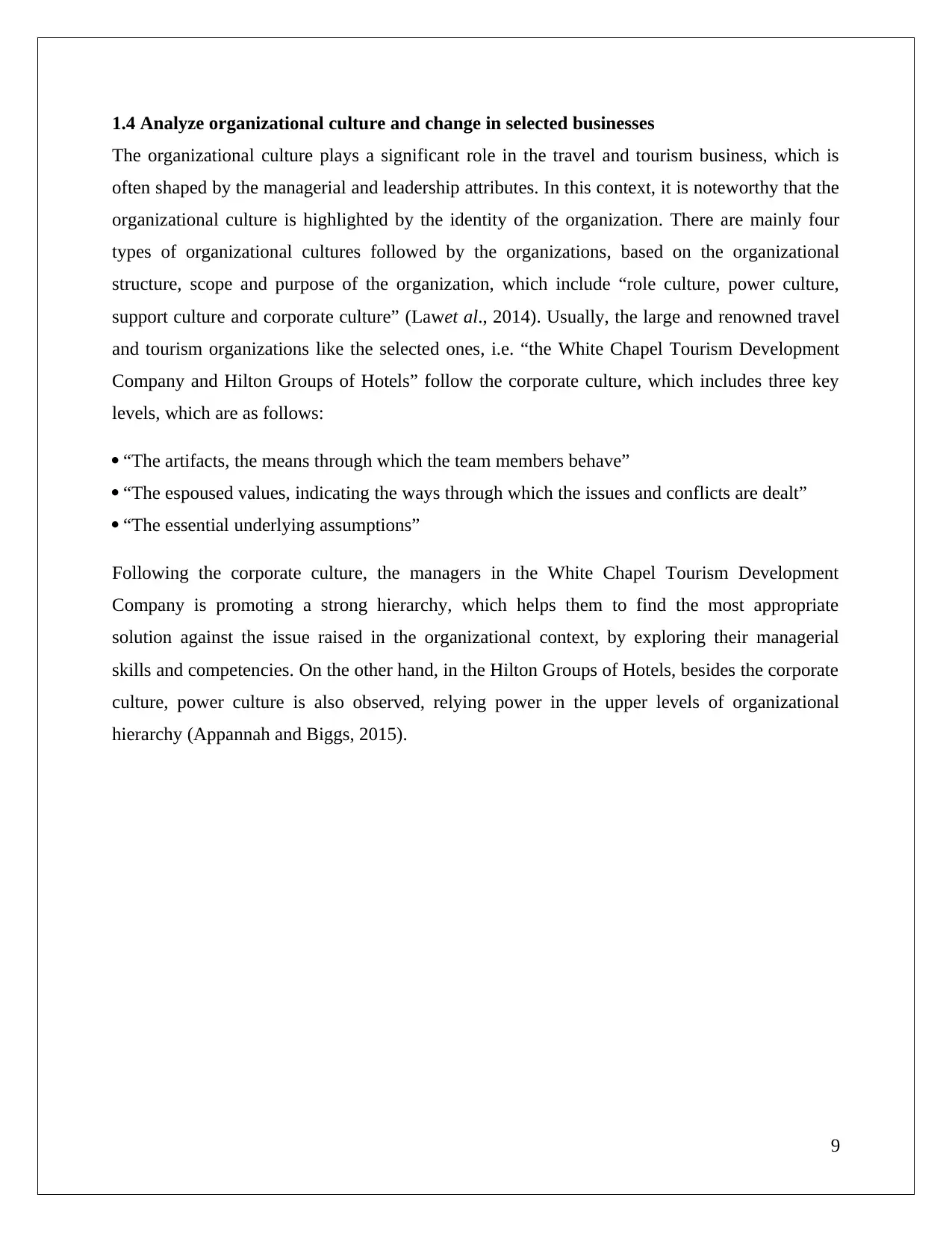
1.4 Analyze organizational culture and change in selected businesses
The organizational culture plays a significant role in the travel and tourism business, which is
often shaped by the managerial and leadership attributes. In this context, it is noteworthy that the
organizational culture is highlighted by the identity of the organization. There are mainly four
types of organizational cultures followed by the organizations, based on the organizational
structure, scope and purpose of the organization, which include “role culture, power culture,
support culture and corporate culture” (Lawet al., 2014). Usually, the large and renowned travel
and tourism organizations like the selected ones, i.e. “the White Chapel Tourism Development
Company and Hilton Groups of Hotels” follow the corporate culture, which includes three key
levels, which are as follows:
“The artifacts, the means through which the team members behave”
“The espoused values, indicating the ways through which the issues and conflicts are dealt”
“The essential underlying assumptions”
Following the corporate culture, the managers in the White Chapel Tourism Development
Company is promoting a strong hierarchy, which helps them to find the most appropriate
solution against the issue raised in the organizational context, by exploring their managerial
skills and competencies. On the other hand, in the Hilton Groups of Hotels, besides the corporate
culture, power culture is also observed, relying power in the upper levels of organizational
hierarchy (Appannah and Biggs, 2015).
9
The organizational culture plays a significant role in the travel and tourism business, which is
often shaped by the managerial and leadership attributes. In this context, it is noteworthy that the
organizational culture is highlighted by the identity of the organization. There are mainly four
types of organizational cultures followed by the organizations, based on the organizational
structure, scope and purpose of the organization, which include “role culture, power culture,
support culture and corporate culture” (Lawet al., 2014). Usually, the large and renowned travel
and tourism organizations like the selected ones, i.e. “the White Chapel Tourism Development
Company and Hilton Groups of Hotels” follow the corporate culture, which includes three key
levels, which are as follows:
“The artifacts, the means through which the team members behave”
“The espoused values, indicating the ways through which the issues and conflicts are dealt”
“The essential underlying assumptions”
Following the corporate culture, the managers in the White Chapel Tourism Development
Company is promoting a strong hierarchy, which helps them to find the most appropriate
solution against the issue raised in the organizational context, by exploring their managerial
skills and competencies. On the other hand, in the Hilton Groups of Hotels, besides the corporate
culture, power culture is also observed, relying power in the upper levels of organizational
hierarchy (Appannah and Biggs, 2015).
9
⊘ This is a preview!⊘
Do you want full access?
Subscribe today to unlock all pages.

Trusted by 1+ million students worldwide
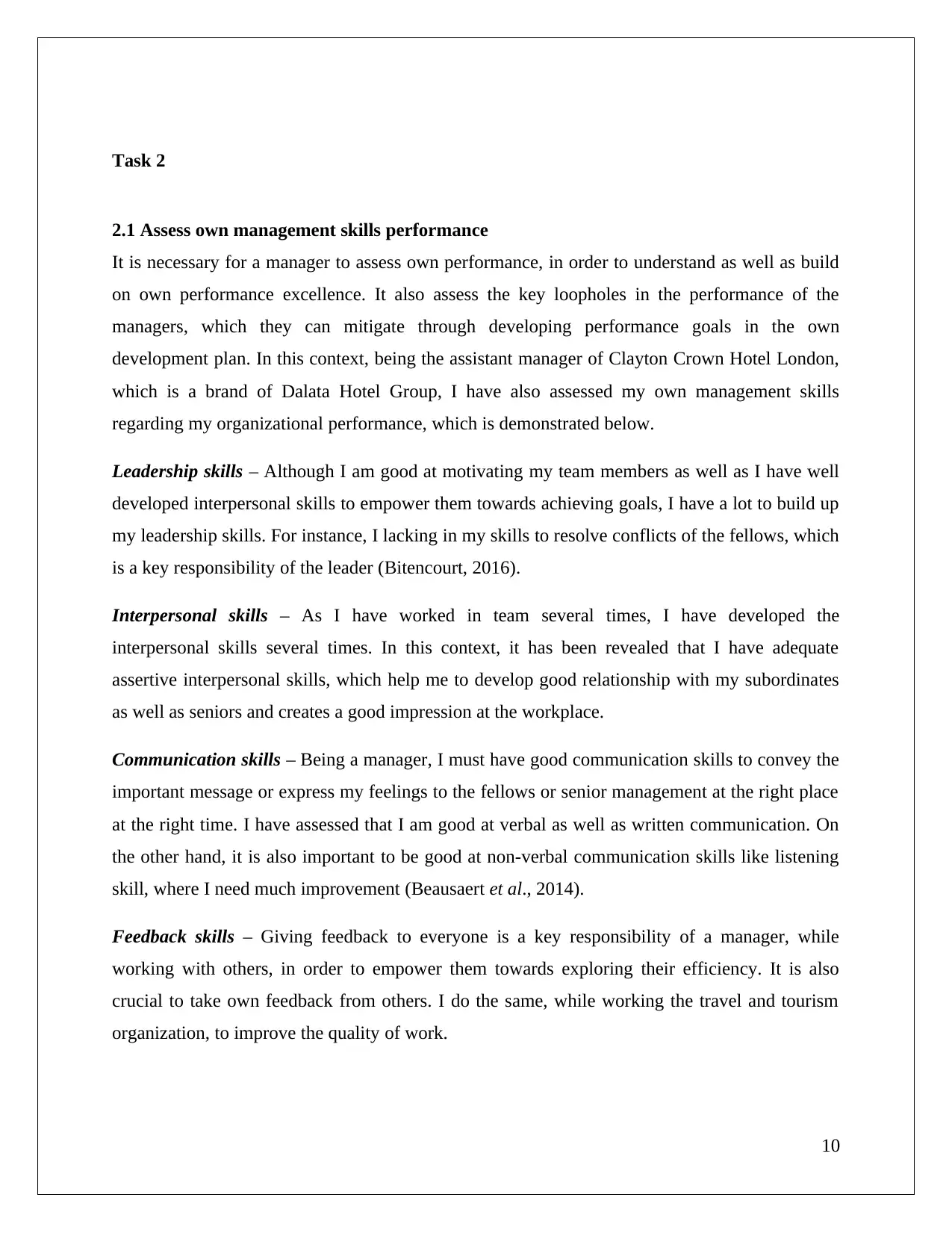
Task 2
2.1 Assess own management skills performance
It is necessary for a manager to assess own performance, in order to understand as well as build
on own performance excellence. It also assess the key loopholes in the performance of the
managers, which they can mitigate through developing performance goals in the own
development plan. In this context, being the assistant manager of Clayton Crown Hotel London,
which is a brand of Dalata Hotel Group, I have also assessed my own management skills
regarding my organizational performance, which is demonstrated below.
Leadership skills – Although I am good at motivating my team members as well as I have well
developed interpersonal skills to empower them towards achieving goals, I have a lot to build up
my leadership skills. For instance, I lacking in my skills to resolve conflicts of the fellows, which
is a key responsibility of the leader (Bitencourt, 2016).
Interpersonal skills – As I have worked in team several times, I have developed the
interpersonal skills several times. In this context, it has been revealed that I have adequate
assertive interpersonal skills, which help me to develop good relationship with my subordinates
as well as seniors and creates a good impression at the workplace.
Communication skills – Being a manager, I must have good communication skills to convey the
important message or express my feelings to the fellows or senior management at the right place
at the right time. I have assessed that I am good at verbal as well as written communication. On
the other hand, it is also important to be good at non-verbal communication skills like listening
skill, where I need much improvement (Beausaert et al., 2014).
Feedback skills – Giving feedback to everyone is a key responsibility of a manager, while
working with others, in order to empower them towards exploring their efficiency. It is also
crucial to take own feedback from others. I do the same, while working the travel and tourism
organization, to improve the quality of work.
10
2.1 Assess own management skills performance
It is necessary for a manager to assess own performance, in order to understand as well as build
on own performance excellence. It also assess the key loopholes in the performance of the
managers, which they can mitigate through developing performance goals in the own
development plan. In this context, being the assistant manager of Clayton Crown Hotel London,
which is a brand of Dalata Hotel Group, I have also assessed my own management skills
regarding my organizational performance, which is demonstrated below.
Leadership skills – Although I am good at motivating my team members as well as I have well
developed interpersonal skills to empower them towards achieving goals, I have a lot to build up
my leadership skills. For instance, I lacking in my skills to resolve conflicts of the fellows, which
is a key responsibility of the leader (Bitencourt, 2016).
Interpersonal skills – As I have worked in team several times, I have developed the
interpersonal skills several times. In this context, it has been revealed that I have adequate
assertive interpersonal skills, which help me to develop good relationship with my subordinates
as well as seniors and creates a good impression at the workplace.
Communication skills – Being a manager, I must have good communication skills to convey the
important message or express my feelings to the fellows or senior management at the right place
at the right time. I have assessed that I am good at verbal as well as written communication. On
the other hand, it is also important to be good at non-verbal communication skills like listening
skill, where I need much improvement (Beausaert et al., 2014).
Feedback skills – Giving feedback to everyone is a key responsibility of a manager, while
working with others, in order to empower them towards exploring their efficiency. It is also
crucial to take own feedback from others. I do the same, while working the travel and tourism
organization, to improve the quality of work.
10
Paraphrase This Document
Need a fresh take? Get an instant paraphrase of this document with our AI Paraphraser
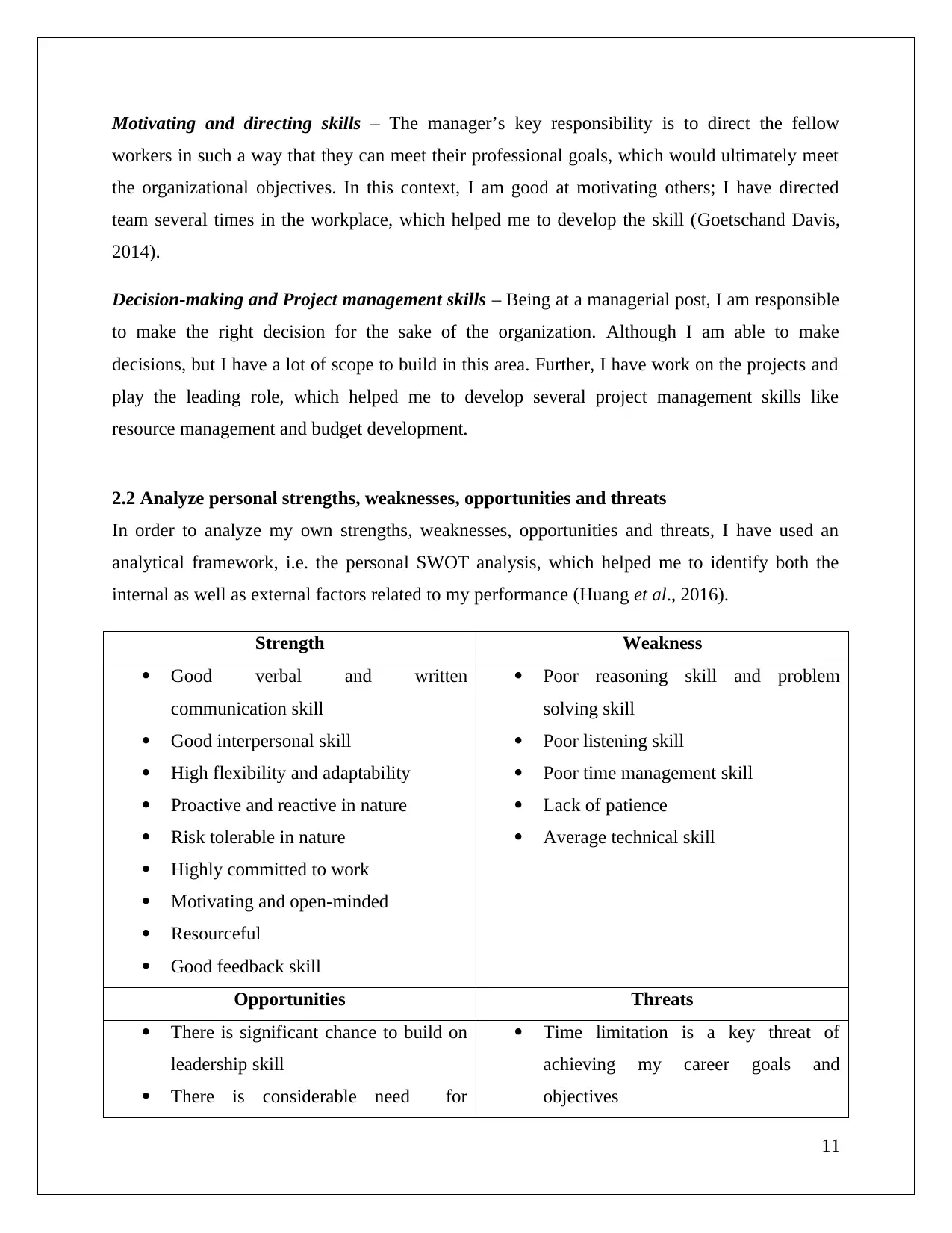
Motivating and directing skills – The manager’s key responsibility is to direct the fellow
workers in such a way that they can meet their professional goals, which would ultimately meet
the organizational objectives. In this context, I am good at motivating others; I have directed
team several times in the workplace, which helped me to develop the skill (Goetschand Davis,
2014).
Decision-making and Project management skills – Being at a managerial post, I am responsible
to make the right decision for the sake of the organization. Although I am able to make
decisions, but I have a lot of scope to build in this area. Further, I have work on the projects and
play the leading role, which helped me to develop several project management skills like
resource management and budget development.
2.2 Analyze personal strengths, weaknesses, opportunities and threats
In order to analyze my own strengths, weaknesses, opportunities and threats, I have used an
analytical framework, i.e. the personal SWOT analysis, which helped me to identify both the
internal as well as external factors related to my performance (Huang et al., 2016).
Strength Weakness
Good verbal and written
communication skill
Good interpersonal skill
High flexibility and adaptability
Proactive and reactive in nature
Risk tolerable in nature
Highly committed to work
Motivating and open-minded
Resourceful
Good feedback skill
Poor reasoning skill and problem
solving skill
Poor listening skill
Poor time management skill
Lack of patience
Average technical skill
Opportunities Threats
There is significant chance to build on
leadership skill
There is considerable need for
Time limitation is a key threat of
achieving my career goals and
objectives
11
workers in such a way that they can meet their professional goals, which would ultimately meet
the organizational objectives. In this context, I am good at motivating others; I have directed
team several times in the workplace, which helped me to develop the skill (Goetschand Davis,
2014).
Decision-making and Project management skills – Being at a managerial post, I am responsible
to make the right decision for the sake of the organization. Although I am able to make
decisions, but I have a lot of scope to build in this area. Further, I have work on the projects and
play the leading role, which helped me to develop several project management skills like
resource management and budget development.
2.2 Analyze personal strengths, weaknesses, opportunities and threats
In order to analyze my own strengths, weaknesses, opportunities and threats, I have used an
analytical framework, i.e. the personal SWOT analysis, which helped me to identify both the
internal as well as external factors related to my performance (Huang et al., 2016).
Strength Weakness
Good verbal and written
communication skill
Good interpersonal skill
High flexibility and adaptability
Proactive and reactive in nature
Risk tolerable in nature
Highly committed to work
Motivating and open-minded
Resourceful
Good feedback skill
Poor reasoning skill and problem
solving skill
Poor listening skill
Poor time management skill
Lack of patience
Average technical skill
Opportunities Threats
There is significant chance to build on
leadership skill
There is considerable need for
Time limitation is a key threat of
achieving my career goals and
objectives
11
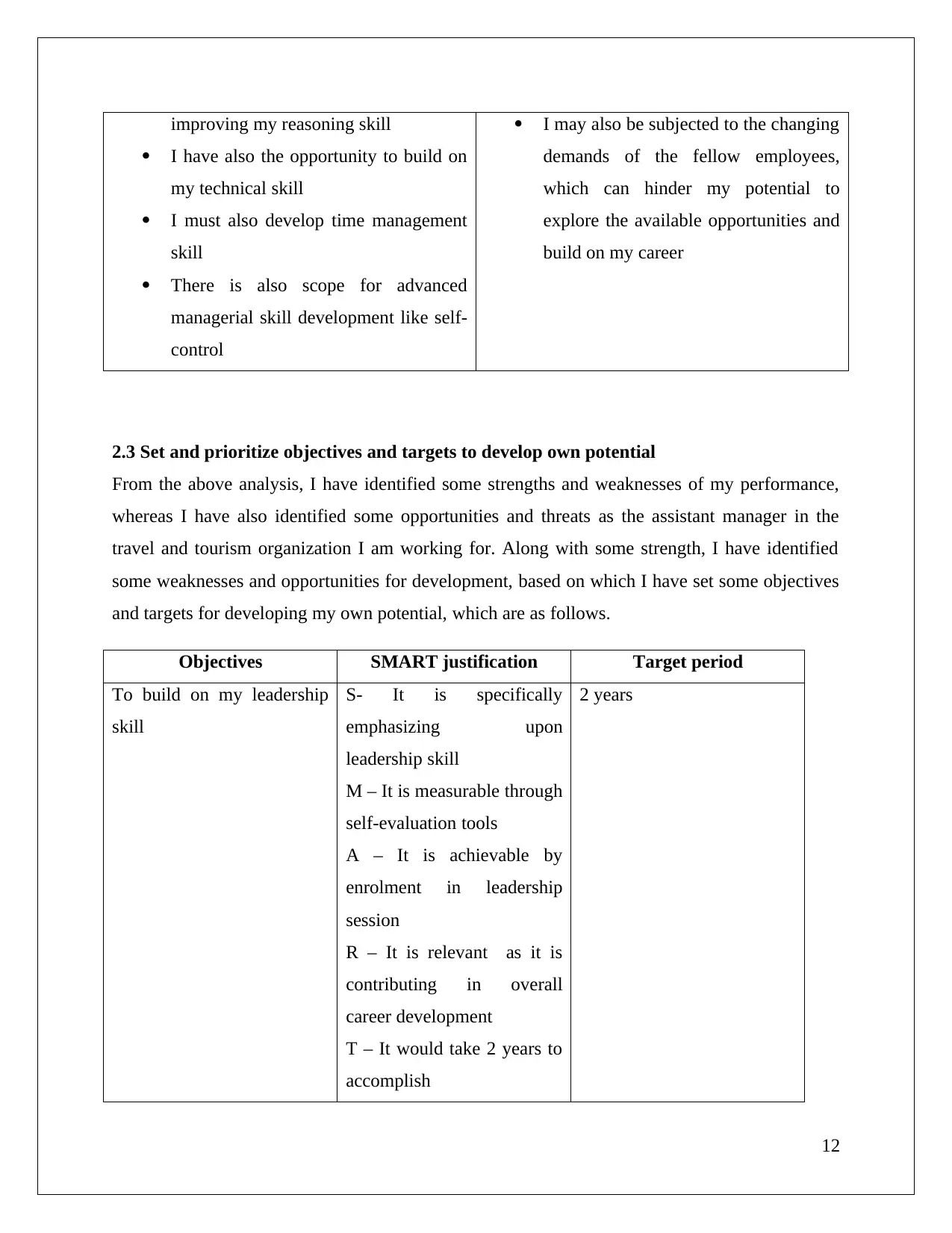
improving my reasoning skill
I have also the opportunity to build on
my technical skill
I must also develop time management
skill
There is also scope for advanced
managerial skill development like self-
control
I may also be subjected to the changing
demands of the fellow employees,
which can hinder my potential to
explore the available opportunities and
build on my career
2.3 Set and prioritize objectives and targets to develop own potential
From the above analysis, I have identified some strengths and weaknesses of my performance,
whereas I have also identified some opportunities and threats as the assistant manager in the
travel and tourism organization I am working for. Along with some strength, I have identified
some weaknesses and opportunities for development, based on which I have set some objectives
and targets for developing my own potential, which are as follows.
Objectives SMART justification Target period
To build on my leadership
skill
S- It is specifically
emphasizing upon
leadership skill
M – It is measurable through
self-evaluation tools
A – It is achievable by
enrolment in leadership
session
R – It is relevant as it is
contributing in overall
career development
T – It would take 2 years to
accomplish
2 years
12
I have also the opportunity to build on
my technical skill
I must also develop time management
skill
There is also scope for advanced
managerial skill development like self-
control
I may also be subjected to the changing
demands of the fellow employees,
which can hinder my potential to
explore the available opportunities and
build on my career
2.3 Set and prioritize objectives and targets to develop own potential
From the above analysis, I have identified some strengths and weaknesses of my performance,
whereas I have also identified some opportunities and threats as the assistant manager in the
travel and tourism organization I am working for. Along with some strength, I have identified
some weaknesses and opportunities for development, based on which I have set some objectives
and targets for developing my own potential, which are as follows.
Objectives SMART justification Target period
To build on my leadership
skill
S- It is specifically
emphasizing upon
leadership skill
M – It is measurable through
self-evaluation tools
A – It is achievable by
enrolment in leadership
session
R – It is relevant as it is
contributing in overall
career development
T – It would take 2 years to
accomplish
2 years
12
⊘ This is a preview!⊘
Do you want full access?
Subscribe today to unlock all pages.

Trusted by 1+ million students worldwide
1 out of 23
Related Documents
Your All-in-One AI-Powered Toolkit for Academic Success.
+13062052269
info@desklib.com
Available 24*7 on WhatsApp / Email
![[object Object]](/_next/static/media/star-bottom.7253800d.svg)
Unlock your academic potential
Copyright © 2020–2025 A2Z Services. All Rights Reserved. Developed and managed by ZUCOL.


